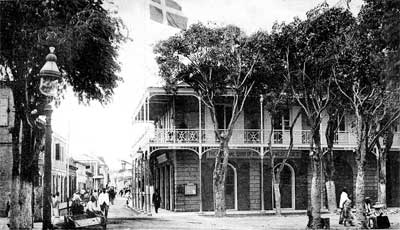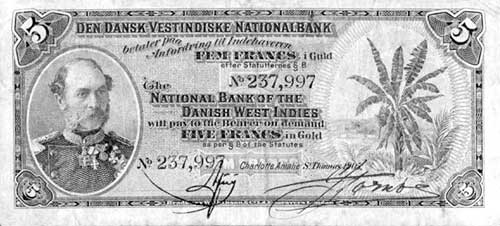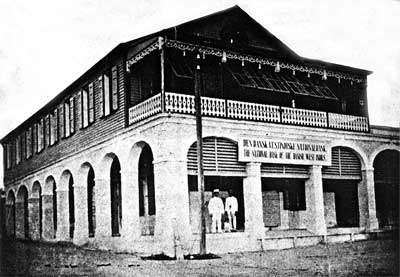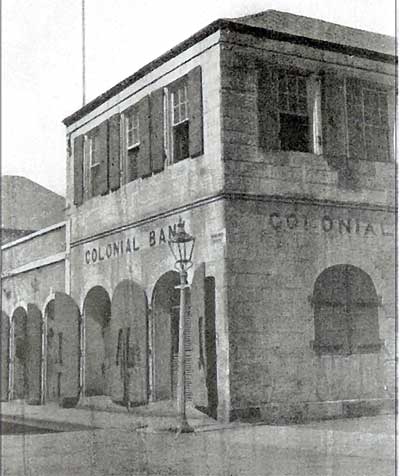A Banker in the Danish West Indian Islands
(Original in Danish, translation courtesy of Nina York.)
(This is an excerpt from an unpublished book of 176 typewritten pages, compiled by an employee of the Danish West Indies National Bank in the early 1900s. As a retiree, he wrote his memoirs of the years in the Danish West Indian Islands, a description that offers a good illustration of the kind of lifestyle which quite a few Danish bankers had a chance to experience, but which ended when the islands were sold to the United States in 1917. We extend our thanks to Nina for making this article available to the Society.)
After the plans to sell the Danish West Indies had been abandoned in 1904, it was decided that the National Bank would establish a branch on our distant tropical islands. For that undertaking there was a need for a bank teller and a bookkeeper.
Head clerk Moller Nielsen was employed at a provincial bank, where he had been for 10 years, but now he had the urge to see something new. The work was monotonous and trivial, and the prospects for advancement were small and in the distant future. A change had to happen. The Danish West Indian Islands? Sure, why not! He applied for the job as bookkeeper, but so did many others. There were 81 applicants for the two positions. However, he must have had some good references, because he was hired as bookkeeper on a three-year contract basis at an annual salary of 5,000 francs, which corresponded to 3.600 kroner, a substantial salary at that time.
Aboard an emigrant ship.
On December 6, 1904 he departed along with the newly hired teller aboard the East Asiatic Company’s steamer “St. Thomas”, a freighter which had been converted to an emigrant ship. The journey lasted for almost a month, because the ship made calls to a number of European ports in order to take on emigrants heading for Mexico and Cuba. When they left Vigo in Spain, they carried 500 emigrants. They then headed straight for St. Thomas, where they arrived January 3, 1905.

National Bank, St. Thomas, D.W.I
The two managing directors of the new bank had arrived earlier in order to prepare for the opening and outline the work. They received the new arrivals and had them installed in a Danish guesthouse, where they received full room and board at a cost of 200 francs a month. It was agreed with the directors to meet at the bank “some time tomorrow” as the premises were not at all ready yet.
Familiar street names
This meant there was plenty of time to look around and familiarize oneself with the new and exotic surroundings. It was strange to walk around the streets of Charlotte Amalie, carrying familiar names such as (Danish version of) Great King Street, Queen Cross Street, and Little Strand Alley. From the signs and advertisements it was evident that many store and company owners were Danish, and the native black people greeted them in broken Danish.
The two new arrivals were instructed to pay a visit to the Governor, and despite the heat, they had to dress up in a Prince Albert. As the completion of the bank premises continued to be delayed, the time available was utilized for visits with Danish families. Everywhere the welcome mat was out, and they felt immediately accepted as part of the “inner circle”.
There was incessant activity; they were invited to get-togethers and parties, indeed, even a ball was arranged in their honor. It was a great experience to move from a quiet Danish provincial town into these lively and exotic surroundings.
Signing new bank notes
The first task our banker was given was to sign the new banknotes, which according to the currency law of 1904 were to be instituted in the islands to supersede the formerly used credit notes of 1 and 5 dollars. Concurrently with these, Spanish gold coins of 25 pesetas were also in use. Moreover, as a sort of reserve in the Government coffers Spanish pieces of gold were held, the so-called Doubloons. All these would now be superseded by the new franc currency.

It can’t be denied that Moller Nielsen felt greatly honored in having been entrusted with the signing of the banknotes of the islands. He sent two of them home to his father, who was no less proud than his son. He had the banknotes framed, and they are still in the family’s possession.
Money exchange on St. Croix
On January 30, Moller Nielsen was sent to St. Croix in order to carry out the money exchange there. The boxes of new banknotes that they brought with them were deposited at the Fort in Frederiksted and were daily removed and returned under armed escort by military gendarmes. The gold coins that were turned in had to be weighed on gold scales in order to ascertain that they were of full weight; otherwise they would be rejected. No less than 600,000 francs were exchanged for gold, and furthermore, Moller Nielsen had delivered to him the Government’s reserves of gold doubloons, so he returned to St. Thomas with a supply that corresponded to 2 1/2 million francs.
Dancing in the heat
In the meantime, the bank in Charlotte Amalie on St. Thomas had opened, so Moller Nielsen could now get started with his work as bookkeeper. Life then became a little more sedate, during the daytime that is, for the evenings and Sundays were constantly filled with get-togethers, picnics, parties and balls. Dancing was indeed very popular and that could be rather exhausting during the warm evenings and nights. During one ball at the Governor’s our banker used up two dress shirts, four collars, and six handkerchiefs.
Signals to festivities
Many ships called regularly on the port of Charlotte Amalie for provisions and to get coal and drinking water. Also many naval vessels from foreign nations called there, and that was an immediate signal to staging festivities for the naval officers and the crew.

Frederiksted branch of the National Bank of the
Danish West Indies
(courtesy of Paula Wilson-St. Croix Landmarks Society)
When the cannon salutes were heard from the Fort and the naval ships returned the greeting, people gathered at the harbor to receive the visitors. The ship visits put money in the merchants’ coffers and this resulted in activity at the banks as well.
Back to gold
There happened to also be an English bank, “Colonial Bank”, and they were not happy about having competition, particularly one with a Royal authorization and the right to issue banknotes. As soon as the English bank came into possession of the new banknotes, they immediately sent a messenger to “The National Bank of the Danish West Indies” in order to have them exchanged for gold. The notes did carry the notation that they could be exchanged for gold.
Back and forth with the contents of the cash box In August 1905 branches were opened on St. Croix, and Moller Nielsen became administrator. Four days a week the bank was opened in Frederiksted, where he arranged to rent a house. Two days a week he had to go to Christiansted in order to do banking there. The drive is 27 kilometers, each way with a horse carriage, carrying the cash box contents. The climate in Frederiksted is not as good as in St. Thomas, and it was not quite as lively, but here too there were get-togethers and parties. It was important to get to know the people and living conditions, and “Bank-master” Moller Nielsen was a welcome guest. The personnel in the branch, aside from the administration, included Jensen, a former soldier, and the Negro James, who was a messenger.
Tropical diseases
It is not accurate that there was nothing but parties and fun; there was also a reverse of the medal. The intense heat necessitates that meat and fish must be consumed the same day it has been slaughtered or caught, but just the same, many intestinal infections occur, some of which can be very serious. There are many insects and various kinds of vermin. Ants and cockroaches find their way indoors, and you have to get used to that.
The Negroes that were employed as servants by the white families were often very faithful and friendly, while those working on the plantations and in the factories were hostile. When they were gathered on certain occasions, the streets in the evening and during the night would resound with shouting and screaming, and then it was wise to stay indoors. So it could be seen as risky for Moller Nielsen to travel alone to and from Christiansted with the cash box.
Acquired a revolver
As a result thereof, he acquired a revolver, but nothing happened on these journeys. There was, however, a break-in at the bank, which however was soon cleared up and resulted in the use of a more secure box.
What parties can lead to…
Sooner or later, parties, dances and pretty girls lead to romance and subsequent engagements and marriages. Our two bankers became enamored of two sisters, who were daughters of a leading merchant, who in addition was the consul for a number of countries and a well known and highly respected person in the islands. The family lived in a large building, “Bluebeards Castle” on one of the hill slopes east of Charlotte Amalie with a splendid view of the town and harbor. On the day Moller Nielsen’s colleague was married to one daughter, he became engaged to the other daughter.
Big wedding
Moller Nielsen’s own wedding took place on January 17, 1906, and he writes in his memoirs with a certain bashfulness and astonishment about the festivities that took place on this occasion. He was probably aware of the fact that it was primarily on account of the family of the bride that it was an occasion in which the entire town took part. The flags were flying everywhere and even the ships in the harbor had donned all their flag decorations. The in-laws had invited 100 guests, among them also the officers of a German and a Russian naval vessel at anchor in the harbor. Lovely gifts piled up and there was an abundance of beautiful tropical flowers. The many splendid uniforms, the lovely ladies and the entire setting must have looked like an operetta wedding. It seemed quite unreal to a young banker that one year after his arrival, he would be at the center of all this.

The Old Colonial Bank, St. Thomas
When the couple a few days later arrived in St. Croix, they had to engage in many festivities there as well, but eventually daily life resumed, and they had a chance to enjoy the house they had rented and furnished. It was a great relief when a banker from Copenhagen took over the Christiansted branch, which relieved Moller Nielsen of the long drive twice a week. Both branches on St. Croix could henceforth stay open all weekdays from 9 to 12 and 1 to 4.
Competitor Closes
The English “Colonial Bank” eventually succumbed to the competition and closed its St. Croix branch as well as the main office in Charlotte Amalie. That resulted in more work for the Danish bank, which also took on the treasury activity of the Government, such as the collection of taxes, payment of customs duties, disbursement of pensions and salaries and sale of stamped papers.
Had to return home due to illness
A couple of times Moller Nielsen suffered with illness, but in July 1907 he had a severe case of dysentery, serious enough to require his return to Denmark to recover. He received six months’ leave with full salary, and when the leave was terminated, he would have to consider whether or not to renew his contract. It was a difficult transition to return to the quieter and calmer surroundings, but probably hardest for his wife, who was born and grew up in the islands. After some time of medical treatment the illness was overcome and he gradually regained his strength, but the condition had been so serious that he decided to stay in Denmark. He applied for work at one of the major banks and after a couple of years became administrator of a branch in Copenhagen.
